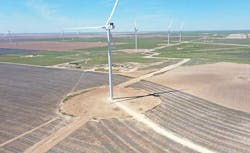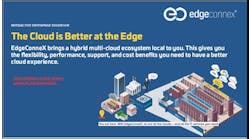New Concepts of the Sustainable Data Center Arise Amid an Evolving Market
Sustainability is now a top-of-mind issue in data center construction and management, as cloud computing and digital transformation fuel the world’s growing thirst for processing power. This new special report series explores the future of the sustainable data center and its impact on the industry.
Get the full report.
The Rise of the Sustainable Data Center
Sustainability is now a top-of-mind issue in data center construction and management, as cloud computing and digital transformation fuel the world’s growing thirst for processing power. Energy Innovation Policy & Technology reports that global IP traffic increased ten-fold between 2010 and 2018, the number of compute instances running on the world’s servers increased more than six-fold and data center storage capacity skyrocketed by a factor of 25. Some of the world’s largest data centers now consume enough electricity to power 80,000 homes.
And workloads are only going to grow more. A profusion of GPUs and CPUs are being deployed to support a burgeoning number of artificial intelligence applications. Smart devices equipped with 5G wireless networks will give rise to smaller but numerous edge data centers.
The growth of connected devices is driving not only demand for power to operate them but also data centers that connect to them. Vertiv estimates that the move to 5G is likely to increase total network energy consumption by between 150% and 170% by 2026, with the largest increases coming in macro, node and network data center areas. One 2017 study forecast that the communications industry could use 20% of the world’s electricity by 2025 and generate 14% of global emissions by 2040, or about as much as the entire U.S. does today.
All of this is occurring against the backdrop of growing global concerns about keeping water supplies safe and limiting the use of fossil fuels. To some degree there is a trade-off between the two. About 40% of the power consumed by data centers goes to the air-conditioning used to cool equipment. That figure can be significantly reduced through the use of evaporative cooling technologies, but the gains come at the expense of increased water usage and additional costs and steps needed to keep water supplies clean. Achieving the most sustainable solution requires balancing both variables.
New Ideas About Sustainability
Hyperscale data center operators have broadly embraced the goal of sustainable operations and have contributed some important innovations while significantly reducing their own power use. For example, Google’s data centers today support an average of seven times more computing power than they did five years ago but use no more electricity. Data center electricity consumption increased just 4% between 2010 and 2014, far below the 24% increase of the previous five years, according to the U.S. Data Center Energy Usage Report. Energy use is expected to increase at an even slower rate in the future.
Part of this slowing growth is due to the widespread use of server virtualization, which has reduced the number of servers needed in data centers while driving up utilization rates. Hyperscalers have also been leaders in the use of power purchase agreements with renewable energy providers to create a cost-effective alternative to building out their own renewable infrastructure while funding investments in sustainable sources. Innovations like Google’s “carbon-intelligent” data center design shifts workloads automatically to maximize the use of carbon-neutral power sources.
Voltage fluctuations and dropouts of as little as 30 milliseconds can damage IT equipment, triggering expensive outages.
But despite the industry’s voracious appetite for power, data center operators for the most part have moved cautiously to adopt alternative energy sources on a large scale. This does not reflect reticence their part but rather the need to balance sustainability with resiliency.
Data centers require power that is both high-quality and predictable. Voltage fluctuations and dropouts of as little as 30 milliseconds can damage IT equipment, triggering expensive outages. Statista reported that the median cost of enterprise server downtime in 2019 was between $400,000 and $500,000 with 15% of enterprises reporting costs of greater than $5 million. For operators of multi-tenant data centers the potential costs are much higher, including lost business, penalties for failure to meet service level agreements and legal exposure.
UPSes not only protect against outages but eliminate the fluctuations of power taken directly from the grid.
Sustainable energy sources such as solar and wind are inherently unpredictable because of their dependence upon weather conditions. Fuel cells show promise, but they are currently expensive and immature. Solar and wind can be useful as an ancillary power supply but the cost of storing enough power to insure against disruptions—combined with the cost of siting, installing and maintaining equipment—is so high as to be impractical for many operators. Power purchase agreements can provide many of the same benefits without the high capital costs.
The need for stable and clean power is one of the reasons most data centers maintain multiple uninterruptible power supplies. UPSes not only protect against outages but eliminate the fluctuations of power taken directly from the grid. Unfortunately, most data center UPSes are under-utilized by design. The units are most efficient when operating at about 80% capacity, but data center operators typically run them at no more than 20% capacity to ensure availability in the event of an outage. That adds up to a substantial amount of battery capacity that is effectively wasted.
This unused capacity could potentially be a resource to stabilize the electrical grid, boost usage of sustainable energy and create financial benefits for both data center operators and the utilities from which they buy their power. Unused UPSes battery capacity could be used to make sustainable energy sources more practical and even improve the overall health of the energy grid.
Stay tuned for more entries in this Data Center Frontier Special Report series that will take a look at the “smarter grid”, tackling water usage, bracing and embracing change in the data center industry and more.
Get the full report, “The Rise of the Sustainable Data Center,“ for a new special report from Vertiv and Data Center Frontier explores the future of the sustainable data center and its impact on the industry.





